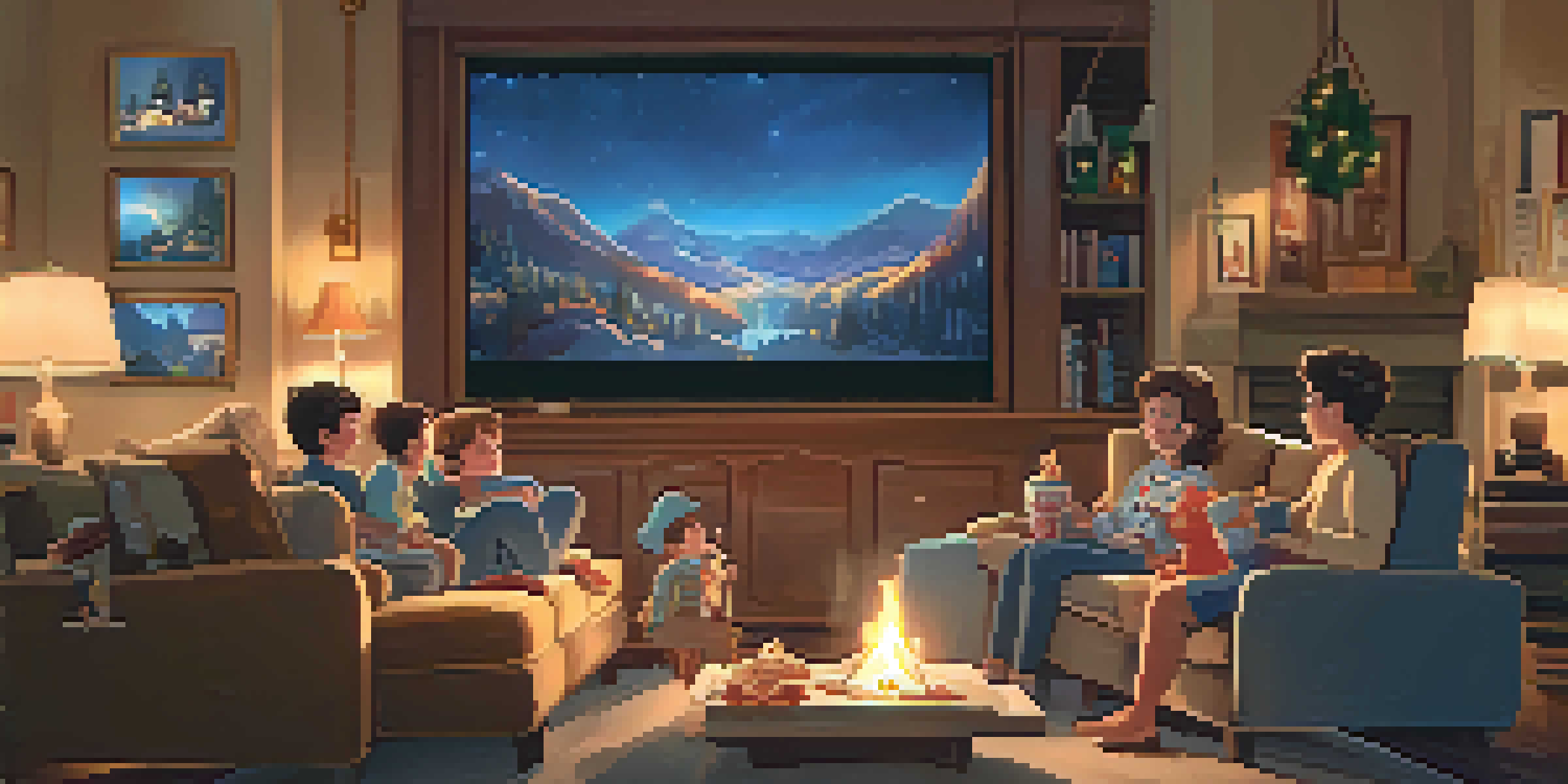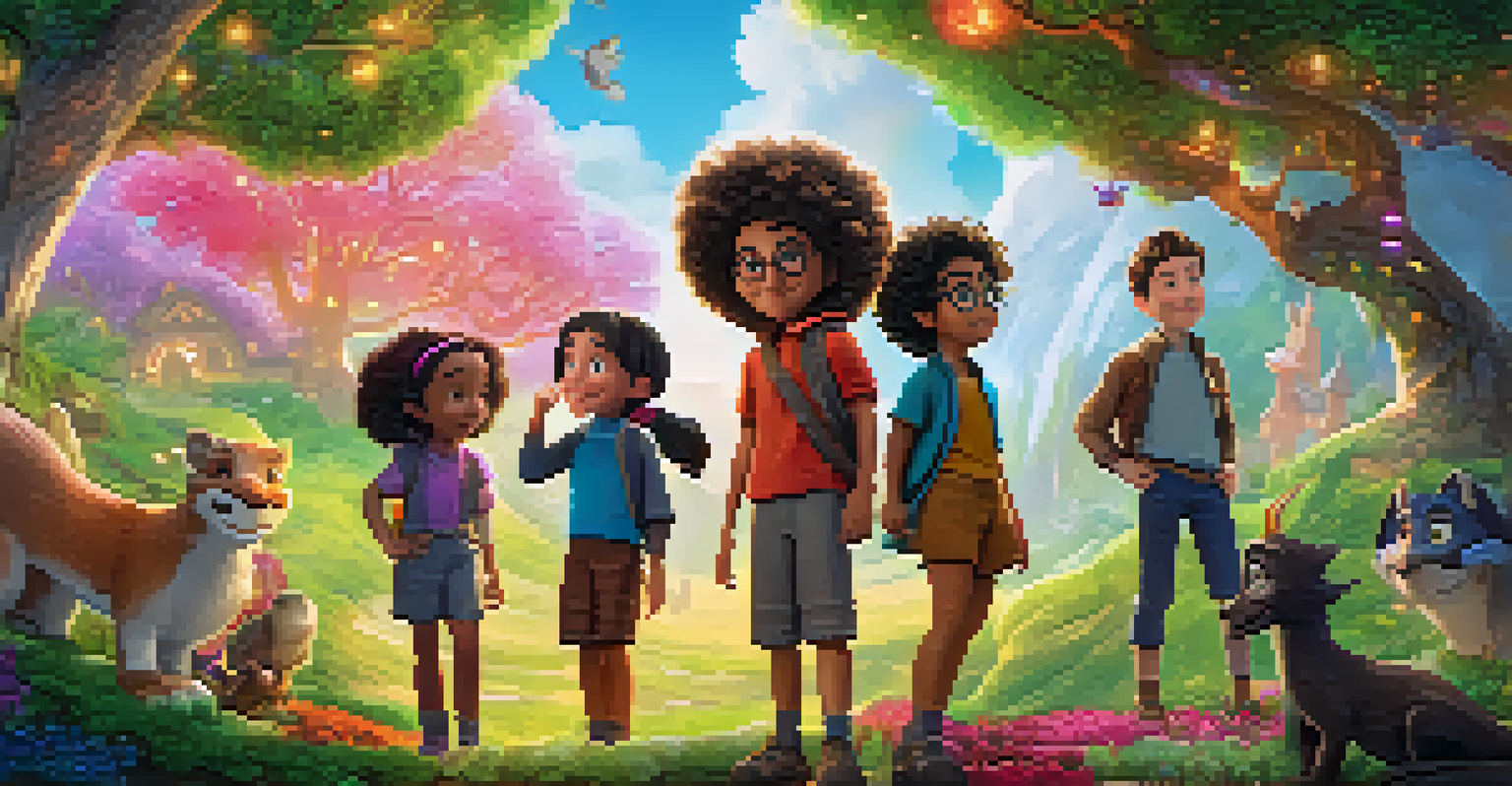The Evolution of Family Films: Shifting Themes and Styles

From Classic Fairy Tales to Modern Storytelling
Family films have long been rooted in classic fairy tales, offering enchanting stories that resonate across generations. These tales often featured simple morals and clear distinctions between good and evil, making them easily digestible for young audiences. However, as societal norms evolved, so did the narratives, shifting from straightforward tales to more complex stories that reflect real-life challenges.
The stories we tell reflect our values and beliefs, and they have the power to shape the future.
In the early days, films like 'Snow White' and 'Cinderella' focused on idyllic worlds and magical resolutions. Today, movies such as 'Frozen' and 'Moana' delve into deeper themes, exploring identity, empowerment, and the importance of family bonds. This evolution mirrors a broader cultural shift towards more nuanced storytelling, inviting families to engage in richer, more meaningful conversations.
Moreover, modern family films often introduce diverse characters and backgrounds, showcasing the importance of inclusion. This variety not only reflects our global society but also enriches the viewing experience, helping children understand and appreciate different perspectives from an early age.
The Rise of Animation: A Game Changer for Family Films
Animation has played a pivotal role in the evolution of family films, transforming how stories are told and experienced. Initially, animated features were seen as simple entertainment for children, with films like 'Dumbo' and 'Bambi' resonating with audiences through charming visuals and heartfelt messages. Over time, animation has matured, becoming a sophisticated medium that appeals to viewers of all ages.

With advancements in technology, studios like Pixar and DreamWorks have pushed the boundaries of animation, creating films that combine stunning visuals with intricate storytelling. Movies such as 'Up' and 'Shrek' not only entertain but also tackle complex themes like loss, love, and self-acceptance. This shift has broadened the scope of family films, making them not just for kids but for everyone.
Evolution of Storytelling in Films
Family films have transitioned from classic fairy tales with simple morals to modern narratives that explore complex themes of identity and empowerment.
Additionally, the integration of humor and adult themes in animated family films has created a unique viewing experience. Parents can enjoy the clever jokes and references while children are captivated by the fantastical elements, ensuring that family movie nights are genuinely enjoyable for all.
The Impact of Technology on Family Film Production
The advent of technology has revolutionized family film production, enabling creators to bring their wildest ideas to life. From CGI to virtual reality, filmmakers now have tools at their disposal that were unimaginable just a few decades ago. This shift has allowed for more creative storytelling, enhancing the visual experience and immersing audiences in vibrant worlds.
Diversity is not a reason for division, but a reason for unity in storytelling.
For instance, films like 'The Lion King' (2019) showcased groundbreaking photorealistic animation, sparking a renewed interest in classic stories while appealing to a new generation. The ability to create lifelike characters and settings has forever changed the landscape of family films, making them more engaging and visually stunning than ever before.
Moreover, technology has also transformed how films are distributed and consumed. Streaming platforms like Disney+ and Netflix have made family films more accessible, allowing families to enjoy a vast library of content from the comfort of their homes. This shift in consumption patterns has reshaped the industry, influencing the types of stories being told and how they reach audiences.
Themes of Diversity and Inclusion in Modern Family Films
Diversity and inclusion have become central themes in contemporary family films, reflecting the rich tapestry of society. As audiences have grown more diverse, filmmakers have recognized the importance of representing different cultures, experiences, and identities on screen. This shift not only enriches storytelling but also helps children see themselves and others in the characters they admire.
Films like 'Coco' and 'Raya and the Last Dragon' highlight cultural traditions and values, providing viewers with a glimpse into worlds they may not be familiar with. By embracing diversity, these films foster empathy and understanding, encouraging young audiences to appreciate differences and celebrate uniqueness.
Diversity and Inclusion in Cinema
Contemporary family films increasingly showcase diverse characters and cultural backgrounds, fostering empathy and understanding among young audiences.
Additionally, family films are increasingly addressing social issues, such as gender equality and environmental awareness. By weaving these themes into their narratives, filmmakers are equipping the next generation with the knowledge and tools to navigate an ever-changing world, making family films a powerful medium for social change.
The Role of Humor in Family Films: Then and Now
Humor has always been a cornerstone of family films, but its role has evolved significantly over the years. In classic films, slapstick comedy and lighthearted antics were the primary sources of laughter, appealing to younger viewers while keeping adult audiences entertained. As storytelling has become more sophisticated, humor has transformed to include wit, irony, and cultural references that resonate with both kids and parents alike.
Modern family films, such as 'The Incredibles' and 'Despicable Me,' cleverly blend humor with relatable situations and character dynamics. This approach not only entertains but also encourages families to engage in discussions about the themes presented in the film. The result is a multi-layered comedic experience that ensures everyone leaves the theater with a smile.
Moreover, the incorporation of humor can also serve to address serious topics in a more approachable way. By using comedy to tackle issues like friendship, acceptance, and resilience, filmmakers create an opportunity for families to discuss these important themes in a relaxed setting, fostering deeper connections in the process.
Family Films as Reflection of Societal Values
Family films often serve as a mirror to societal values, evolving in response to changing cultural landscapes. In the past, films frequently portrayed traditional family structures and gender roles, reflecting the norms of their time. As society has progressed, family films have adapted by showcasing a wider range of family dynamics, including single-parent households and LGBTQ+ representation.
For example, movies like 'Finding Dory' highlight the importance of family, regardless of its form, emphasizing love and support over traditional definitions. This shift not only reflects our growing acceptance of diverse family structures but also reinforces the idea that what truly matters is the bond between loved ones.
Future Trends in Family Films
Emerging trends like interactive storytelling and a focus on environmental issues are set to shape the future of family films, enhancing engagement and social responsibility.
Additionally, family films now often incorporate themes of social responsibility and activism, encouraging young audiences to be aware of the world around them. By addressing issues like climate change and kindness, filmmakers are instilling values that will shape future generations, making family films a vital tool for social commentary and education.
The Future of Family Films: Trends to Watch
As we look to the future, several trends are emerging in the world of family films that promise to shape their evolution. One significant trend is the continued focus on representation, with filmmakers striving to tell stories that reflect the diversity of their audiences. This commitment to inclusivity is likely to drive the creation of more unique characters and narratives that resonate with viewers from all walks of life.
Another trend is the rise of interactive storytelling, fueled by advancements in technology. With the popularity of platforms that allow viewers to influence the story's direction, the traditional passive viewing experience may evolve into an engaging and participatory one. This shift could revolutionize how families enjoy films together, creating a shared adventure that enhances connection.

Finally, as environmental concerns become increasingly pressing, expect family films to tackle ecological issues in innovative ways. By weaving messages of sustainability and conservation into their stories, filmmakers can inspire a sense of responsibility in young audiences, ultimately shaping a more conscious and caring generation.